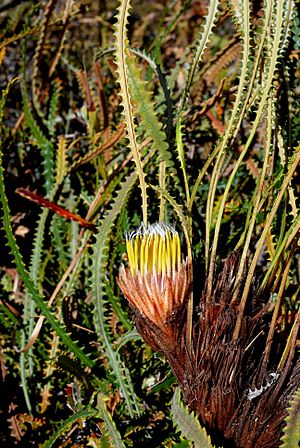Summer honeypot facts for kids
Quick facts for kids Summer honeypot |
|
|---|---|
 |
|
| Conservation status | |
| Scientific classification | |
| Genus: |
Banksia
|
| Species: |
mimica
|
| Synonyms | |
|
Dryandra mimica A.S.George |
|
The summer honeypot (Banksia mimica) is a special kind of plant found only in Western Australia. It's a low-growing shrub that spreads out along the ground. It has unique wedge-shaped leaves with sharp teeth. When it flowers, you'll see yellow blooms in small groups, and later, it grows fuzzy, oblong seed pods.
Contents
What the Summer Honeypot Looks Like
The summer honeypot is a shrub that grows flat on the ground. It has short stems that stay underground. It also has a special woody lump called a lignotuber that helps it survive fires.
Its leaves are shaped like a wedge, about 13 to 35 centimeters (5 to 14 inches) long. They are 0.5 to 1.5 centimeters (0.2 to 0.6 inches) wide. Each leaf sits on a stalk, called a petiole, which is about 4 to 6 centimeters (1.6 to 2.4 inches) long. The edges of the leaves have many sharp teeth, usually between 20 and 60 on each side! The underside of the leaves is very hairy and has a clear line down the middle.
The flowers are bright yellow. They grow close to the ground in groups, with 20 to 50 flowers in each head. At the base of each flower head are tapering, hairy leaves called involucral bracts, about 1.7 to 2.3 centimeters (0.7 to 0.9 inches) long.
The flower's outer part, called the perianth, is about 2.5 to 3 centimeters (1 to 1.2 inches) long and hairy. The part that receives pollen, called the pistil, is about 2.4 to 2.7 centimeters (0.9 to 1.1 inches) long and smooth.
When Does it Flower?
The summer honeypot usually flowers from December or January to February. After flowering, it produces seed pods called follicles. These pods are about 1.3 to 2 centimeters (0.5 to 0.8 inches) long and 0.8 to 1 centimeter (0.3 to 0.4 inches) wide. They are covered in flattened hairs.
How it Got its Name
The summer honeypot was first officially described in 1985 by a scientist named Alex George. He gave it the name Dryandra mimica. He found the plant in a suburb of Perth called Wattle Grove.
The word mimica comes from a Latin word meaning "imitative." This name was chosen because the summer honeypot looks a lot like another plant called Dryandra nivea (which is now known as Banksia nivea).
Later, in 2007, two other scientists, Austin Mast and Kevin Thiele, moved all the Dryandra plants into the Banksia group. That's how this plant became known as Banksia mimica.
Where the Summer Honeypot Lives
The summer honeypot grows in three separate areas in Western Australia. These areas are near Mogumber, on the Darling Range east of Perth, and in the Whicher Range near Busselton. It likes to grow in woodlands, shrublands, or low heath areas.
Why This Plant Needs Our Help
The summer honeypot is considered "endangered" by the Australian Government. This means it's at high risk of disappearing forever. It's also listed as "Threatened Flora" by the Department of Environment and Conservation in Western Australia.
The biggest dangers to this plant are when land is cleared for farming or for building new homes and towns. Protecting its habitat is very important to help it survive.


